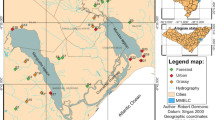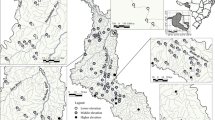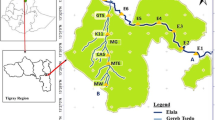Abstract
The relationships between environmental variables, distribution of freshwater fishes and their diet were investigated at 40 sites on irrigation ditches for rice fields in central Japan. Multivariate analyses showed that fish species richness and diversity in ditches was high when fishes were able to easily invade the rice fields. Natural stream beds not covered by concrete had greater total number and biomass of fishes in irrigation ditches. The connection between ditches and rice fields was of secondary importance. Canonical correlation analysis indicated that the two principal fish community variables, abundance and diversity, were respectively represented by the presence of the minnow, Gnathopogon elongatus elongatus, and the absence of the loach, Misgurnus anguillicaudatus. Most fishes in the irrigation ditches predominantly preyed upon aquatic insects such as ephemeropteran nymphs, chironomid larvae and trichopteran larvae, but aerial insects and benthic algae were also fed upon by a few species. Small fishes (<4 cm SL) preyed more on chironomid and less on trichopteran larvae than large (≥4 cm SL) fishes. The diet overlap between species was extremely high for small fishes in ditches weakly connected with rice fields. The recent changes in rice fields and irrigation ditches to increase production efficiency has led to a decrease in fish diversity. For the coexistence of rice production and fish diversity in rice areas, a new irrigation system, where fishes can easily invade rice fields and where plenty of invertebrates are available for fishes, should be developed.
Similar content being viewed by others
References cited
Bowlby, J.N. & J.C. Roff. 1986. Trout biomass and habitat relationships in southern Ontario streams. Trans. Am. Fish. Soc. 115: 503-514.
Collins, W.W. & C.O. Qualset. 1999. Biodiversity in Agroecosystems. CRC Press, Boca Raton. 334 pp.
Di Castri, F. & T. Younes. 1996. Biodiversity, Science and Development-towards a New Partnership. Cab International, Oxon. 646 pp.
Ezaki, Y. & T. Tanaka. 1998. Conservation of Biological Communities in Rivers, Ponds and Paddy Fields. Asakura Shoten, Tokyo. 220 pp. (in Japanese).
Fasola, M. & X. Ruiz. 1996. The value of rice fields as substitutes for natural wetlands for waterbirds in the Mediterranean region. Colonial Waterbirds 19: 122-128.
Fasola, M., L. Canova & N. Saino. 1996. Rice fields support a large portion of herons breeding in the Mediterranean region. Colonial Waterbirds 19: 129-134.
Finger, T.R. & E.M. Stewart. 1987. Response of fishes to flooding regime in lowland hardwood wetlands. pp. 86-92. In: J. Matthews & D.C. Heins (ed.) Community and Evolutionary Ecology of North American Stream Fishes, University of Oklahoma Press, Norman.
Fujioka, M. & S.J. Lane. 1997. The impact of changing irrigation practices in rice fields or frog populations of the Kanto Plain, central Japan. Ecol. Res. 12: 101-112.
Hanson, D.L. & T.F. Waters. 1974. Recovery of standing crop and production rate of a brook trout population in a flood-damaged stream. Trans. Am. Fish. Soc. 103: 431-439.
Harden-Jones, F.R. 1968. Fish Migration. Arnold, London. 325 pp.
Healy, B.D. & D.G. Lonzarich. 2000. Microhabitat use and behavior of overwintering juvenile coho salmon in a Lake Superior tributary. Trans. Am. Fish. Soc. 129: 866-872.
Hosoya, K. 1982. Freshwater fish fauna of the Yoshii River, Okayama Prefecture. Bull. Biogeogr. Soc. Japan 37: 23-35.
Ichimura, S. 1954. Ecological studies on the plankton in paddy fields. I. Seasonal fluctuations in the standing crop and productivity of plankton. Jap. J. Bot. 14: 269-279.
Iguchi, K., M. Yoshiba, W.Wu & N. Shimizu. 1999. Biodiversity of freshwater fishes in the paddy water system of Anji, China. Bull. Nat. Res. Inst. Fish. Sci. 13: 27-36.
JISC (Japanese Industrial Standards Committee). 1986. Testing Methods for Industrial Waste Water, JIS K 0102. Japanese Standards Association, Tokyo. 254 pp. (in Japanese).
John, K.R. 1964. Survival of fish in intermittent streams of the Chricachua Mountains, Arizona. Ecol. 45: 112-119.
Katano, O. 1998. Fish communities in rice fields and irrigation ditches. pp. 67-79. In: Y. Ezaki & T. Tanaka (ed.) Conservation of Biological Communities in Rivers, Ponds and Paddy Fields, Asakura Shoten, Tokyo (in Japanese).
Katano, O., K. Saitoh & A. Koizumi. 1988. Scatter-spawning of the catfish, Silurus asotus. Japan. J. Ichthyol. 35: 203-211 (in Japanese).
Katano, O. & H. Hakoyama. 1997. Spawning behavior of Hemibarbus barbus (Cyprinidae). Copeia 1997: 620-622.
Katano, O. & K. Maekawa. 1997. Reproductive regulation in the female Japanese minnow, Pseudorasbora parva (Cyprinidae). Env. Biol. Fish. 49: 197-205.
Katano, O., K. Hosoya, K. Iguchi & Y. Aonuma. 2001. Comparison of fish fauna among three types of rice fields in the Chikuma River basin. Japan. J. Ichthyol. 48: 19-25 (in Japanese).
Kihira, H. 1983. Changes in fish fauna and environments-fish in irrigation ditches. Freshwater Fish 9: 58-60 (in Japanese).
Kimoto, S. & H. Takeda. 1989. Introduction to Community Ecology. Kyoritsu Shuppan, Tokyo. 198 pp. (in Japanese).
Kondo, T. 1998. Freshwater bivalve communities in irrigation ditches. pp. 80-92. In: Y. Ezaki & T. Tanaka (ed.) Conservation of Biological Communities in Rivers, Ponds and Paddy Fields, Asakura Shoten, Tokyo (in Japanese).
Kurasawa, H. 1956. The weekly succession in the standing crop of plankton and zoobenthos in the paddy field (I). Misc. Rep. Res. Inst. Natur. Res. 41-42: 86-98 (in Japanese).
Lane, S.J. & M. Fujioka. 1998. The impact of changes in irrigation practices on the distribution of foraging egrets and herons (Ardeidae) in the rice fields of central Japan. Biol. Conservation 83: 221-230.
Linton, L.R., R.W. Davies & F.J. Wrona. 1981. Resource utilization indices: An assessment. J. Anim. Ecol. 50: 283-292.
Lucena, F.M., Coloured Illustrations of the Freshwater Fishes of Japan. Hoikusha, Osaka. 462 pp. (in Japanese).
Morisita, M., 1967. Seasonal distribution of butterflies around Kyoto. pp. 95-132. In: M. Morisita & T. Kira (ed.) Nature-Ecological Studies, Chuokoronsha, Tokyo (in Japanese).
Moyle, P.B. & D.M. Baltz. 1985. Microhabitat use by an assemblage of California stream fishes: Developing criteria for instream flow determinations. Trans. Am. Fish. Soc. 114: 695-704.
Murphy, M.L., J. Heifetz, S.W. Johnson, K.V. Koski & J.F. Thedinga. 1986. Effects of clear-cut logging with and without buffer strips on juvenile salmonids in Alaskan streams. Can. J. Fish. Aquat. Sci. 43: 1521-1533.
Nagata, Y. & K. Hosoya. 1997. Circumstances in Endangered Japanese Freshwater Fishes and their Protection. Midori Shobo, Tokyo. 379 pp. (in Japanese).
Naitoh, K. 1981. The development of pipelines for rice fields and its background. Water & Soil 44: 2-5 (in Japanese).
Nakagawa, S. 1978. Movement of water and irrigation for paddy fields. Kagaku 48(10): 605-613 (in Japanese).
Nakamura, M. 1969. Cyprinid Fishes of Japan-Studies on the Life History of Cyprinid Fishes of Japan. Res. Inst. Natur. Res., Tokyo. 455 pp. (in Japanese).
Nickelson, T.E., J.D. Rodgers, S.L. Johnson & M.F. Solazzi. 1992. Seasonal changes in habitat use by juvenile coho salmon (Oncorhynchus kisutch) in Oregon coastal streams. Can. J. Fish. Aquat. Sci. 49: 783-789.
Ross, S.T. & J.A. Baker. 1983. The response of fishes to periodic spring floods in a southeastern stream. Am. Midl. Nat. 109: 1-14.
Saitoh, K., O. Katano & A.Koizumi. 1988. Movement and spawning of several freshwater fishes in temporary waters around paddy fields. Jpn. J. Ecol. 38: 35-47 (in Japanese).
Schoener, T.W. 1970. Nonsynchronous spatial overlap of lizards in patchy habitats. Ecol. 51: 408-418.
SIDMAFFJ (Statistics and Information Department, Ministry of Agriculture, Forestry and Fisheries of Japan). 1998. The Statistical Pocket Book of Agriculture, Forestry and Fisheries. Nourin-toukei Kyokai, Tokyo. 427 pp. (in Japanese).
Sparks, R.E. 1995. Need for ecosystem management of large rivers and their floodplains. Biosci. 45: 168-182.
Stoneman, C.L. & M.L. Jones. 2000. The influence of habitat features on the biomass and distribution of three species of southern Ontario stream salmonines. Trans. Am. Fish. Soc. 129: 639-657.
Suga, T. 1996. Multivariate statistical analysis. Gendai Sugakusha, Kyoto. 326 pp. (in Japanese).
Sullivan, M.J. 1982. Distribution of edaphic diatoms in a Mississippi salt marsh: A canonical correlation analysis. J. Phycol. 18: 130-133.
Tanaka, M. 1999. Influence of different aquatic habitats on distribution and population density of Misgurnus anguillicaudatus in paddy fields. Japan. J. Ichthyol. 46: 75-81 (in Japanese).
Toyoshima, T., S. Nakano, M. Inoue, Y. Ono & Y. Kurashige. 1996. Fish population responses to stream habitat improvement in a concrete-lined channel. Japan. J. Ecol. 46: 9-20 (in Japanese).
Tsukahara, H. 1948. The relation between the secondary sex-characters and the spawning habits in the loach, Misgurnus anguillicaudatus Cantor. Seibutu 3(2): 64-69 (in Japanese).
Turner, T.F., J.C. Trexler, G.L. Miller & K.E. Toyer. 1994. Temporal and spatial dynamics of larval and juvenile fish abundance in a temperate floodplain river. Copeia 1994: 174-183.
Wallace, R.K. Jr. 1981. An assessment of diet overlap indexes. Trans. Am. Fish. Soc. 110: 72-76.
Williams, D.D. 1987. The Ecology of TemporaryWaters. Croom Helm, London. 205 pp.
Williams, D.D. & D.W. Coad. 1979. The ecology of temporary streams III. Temporary stream fishes in Southern Ontario, Canada. Int. Rev. ges. Hydrobiol. 64: 501-515.
Winemiller, K.O., S. Tarin, D. Shormann & J.B. Cotner. 2000. Fish assemblage structure in relation to environmental variation among Brazos River oxbow lakes. Trans. Am. Fish. Soc. 129: 451-468.
Yada, T. 1979. An improvement of collector for the spawning of the 'Tamoroko' (Gnathopogon elongatus elongatus). Bull. Osaka Pref. Freshwater Fish Exp. Sta. 5: 31-32 (in Japanese).
Yanai, H. & H. Takagi. 1986. Handbook for multivariate analysis. Gendai Sugaku-sha, Kyoto. 311 pp (in Japanese).
Author information
Authors and Affiliations
Rights and permissions
About this article
Cite this article
Katano, O., Hosoya, K., Iguchi, K. et al. Species diversity and abundance of freshwater fishes in irrigation ditches around rice fields. Environmental Biology of Fishes 66, 107–121 (2003). https://doi.org/10.1023/A:1023678401886
Issue Date:
DOI: https://doi.org/10.1023/A:1023678401886




